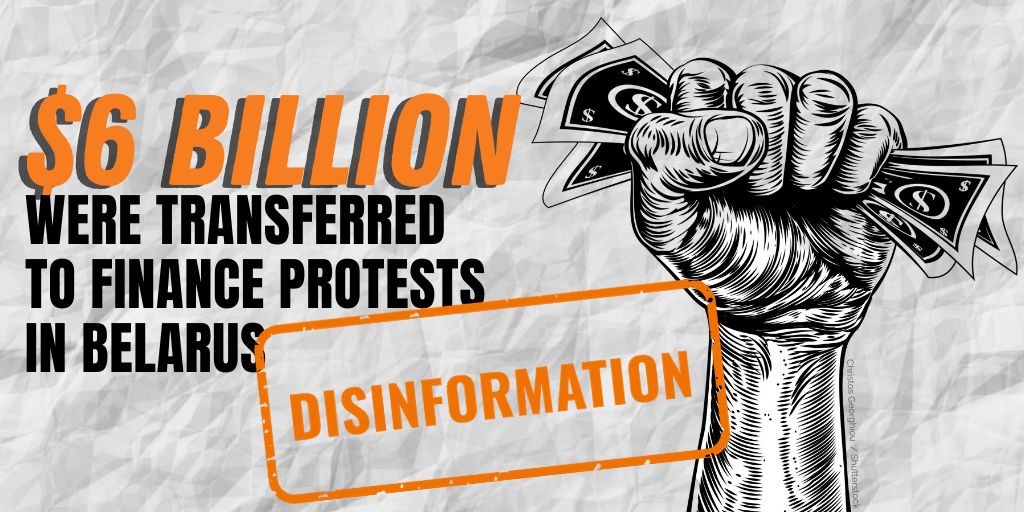
To discredit the ongoing protests in Belarus, both pro-Kremlin and Belarusian state-controlled media rely on an increasingly converging set of disinformation messages. Many of those messages portray Belarusian protesters as pawns, trained and paid for by the West.
Belarusian state-owned news agency Belta reinforced this narrative recently by claiming that 6 billion USD were transferred to finance protests in Belarus. This staggering sum, equivalent to nearly 10% of Belarus’ entire GPD, was supposedly transferred via cryptocurrencies.
This disinformation story originally appeared in the evening news on state-owned All National Television channel. The news programme showed an interview with German “expert” Alexander Sosnovsky, who spoke at length about the alleged “fist of George Soros” and the financing of the protests:
“The European Union allocated considerable means. Now, I recently spoke to a colleague of mine who served for many years as a deputy minister in the German government. According to his testimony, there is information that through various ways, using cryptocurrencies, a total of 6 billion dollars were transferred to [finance] protest events in Belarus”.
Mr Sosnovsky went on to admit that he could not verify the information, but that “it exists”. However, many ordinary Belarusians beg to disagree.https://platform.twitter.com/embed/index.html?creatorScreenName=EUvsDisinfo&dnt=false&embedId=twitter-widget-0&frame=false&hideCard=false&hideThread=false&id=1297577573006880768&lang=en&origin=https%3A%2F%2Feuvsdisinfo.eu%2Ffigure-of-the-week-6-billion%2F&siteScreenName=EUvsDisinfo&theme=light&widgetsVersion=219d021%3A1598982042171&width=550px
That both state news agency and television should publish unverified claims of this magnitude reveals not so much the absence of any discernible journalistic standards as the deep integration of pro-Kremlin disinformation methods and narratives about “Western interference” into Belarusian state-controlled media. This hardly comes as a surprise, given that Belarusian state TV has depended on Russian-produced content for years. In the aftermath of the presidential election, numerous employees of Belarusian state-run radio and television company went on strike and were dismissed. “Specialists from Russia” were invited to take their place. As a result, Belarusian state-run TV channels are now well positioned to spin pro-Kremlin narratives and sow doubt that the rallies are a genuine grassroots protest movement.
Both Mr Sosonosvky and Belarusian state media are deliberately vague about who allegedly made the money transfer – the EU or George Soros. They try to legitimise the narrative by invoking an anonymous source “in the German government” and even admit that the information was not verified. But for disinformation purposes this does not matter. The unverified information that “exists” was not only aired prime-time to Belarusian audiences, it was also spread across social media by groups as colourful as “Russian people in Canada”, “Friedensdemo-watch” (in German language), and of course Belta news agency social media accounts.
Pro-Kremlin experts to the rescue
Since the protests started, Belarusian and Russian state controlled media have increasingly converged in their disinformation narratives: protests are the result of a foreign-sponsored colour revolution, the Maidan scenario is now applied in Minsk, and finally – George Soros is behind all of it.
To back these narratives, Belarusian state media rely on a growing number of “international experts” who express distinctly pro-Kremlin views. Mr. Sosnovsky, presented on Belarusian TV as a “known German political scientist,” is also a known contributor to Sputnik and other pro-Kremlin media outlets, and has suggested in the past that the US was involved in the downing of flight MH17 and the disappearance of flight MH370.
Alongside Mr. Sosnovsky, Belarusian state media resort to a carousel of other “international experts”, including a former Ukrainian politician who praised President Alyaksandr Lukashenka for not giving into COVID-19 “hysteria”; a Bulgarian academic who told protesting Belarusians not to be naïve in their wish for “something new”; and a Serbian folk band that tried to plead with young Belarusians:
“We, too, are young people and we can understand that someone is “tired” of having one president for 26 years. We, inexperienced young people, are very often bored by our parents, especially if they constantly teach us, as a rule, something good and useful! Unfortunately, we usually realize what kind of protection we had only when we lose it.”
But above all, Belarusian airwaves are open to various pro-Kremlin commentators who regularly appear on Russian state-controlled TV. Among them: Nikolai Starikov, a frequent contributor to RIA FAN – a news agency closely affiliated with St. Petersburg’s Troll Factory, who claimed that the protests were organised via the Telegram channels from Poland as people by themselves “cannot go anywhere”; Konstantin Malofeev, sanctioned by the EU for supporting attempts to destabilise Eastern Ukraine; and many other so-called experts who speak at length about “colour revolution scenarios” in Belarus.
By inviting such personalities on their airwaves, Belarusian state-controlled TV aligns itself with well-entrenched pro-Kremlin disinformation narratives targeting popular protests. Meanwhile, useful “international experts” help to normalise and legitimise these narratives as professional opinions.
Despite bogus experts and made-up billions, the people of Belarus continue marching peacefully to demand the respect of their civic and democratic rights.




